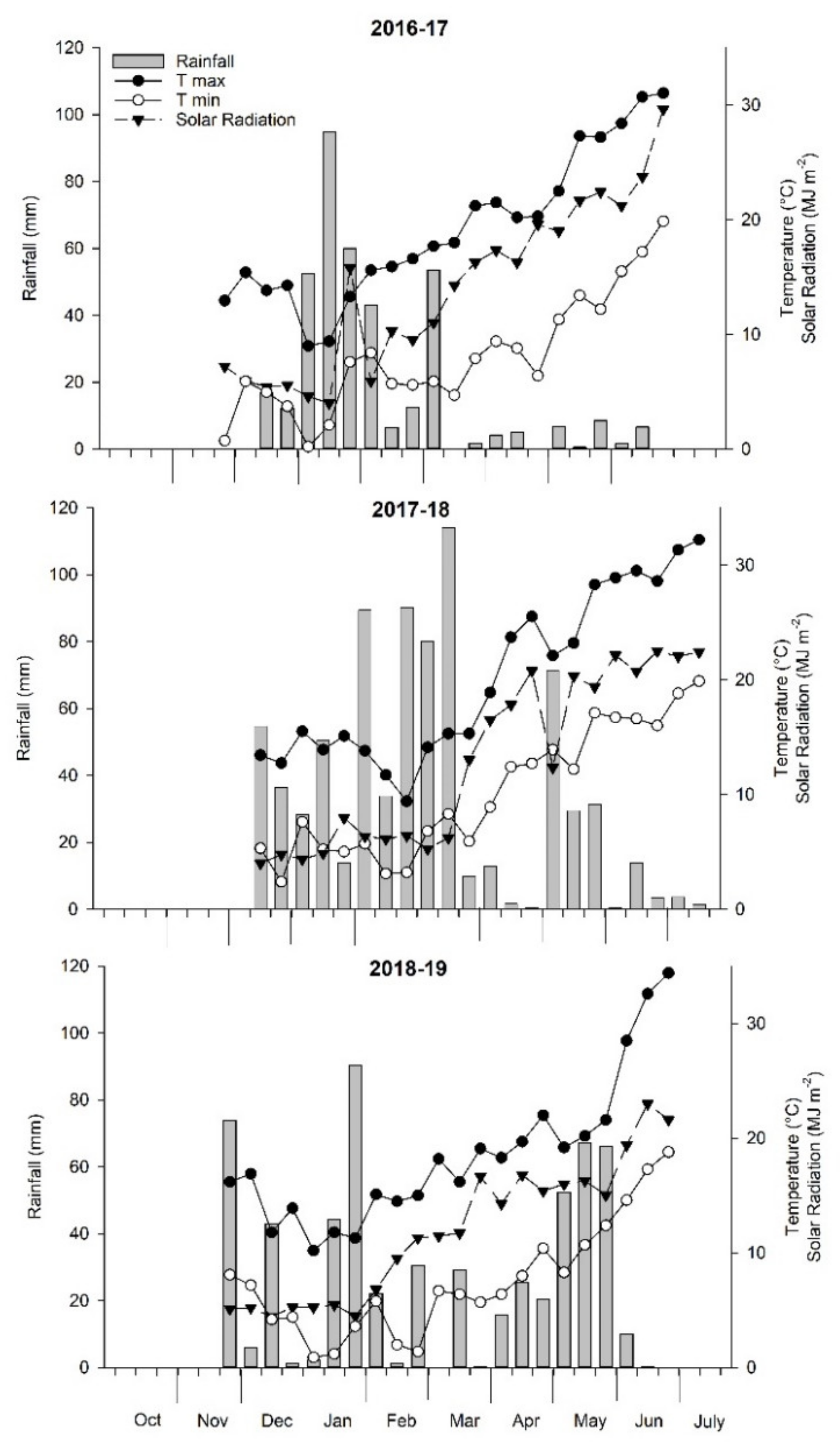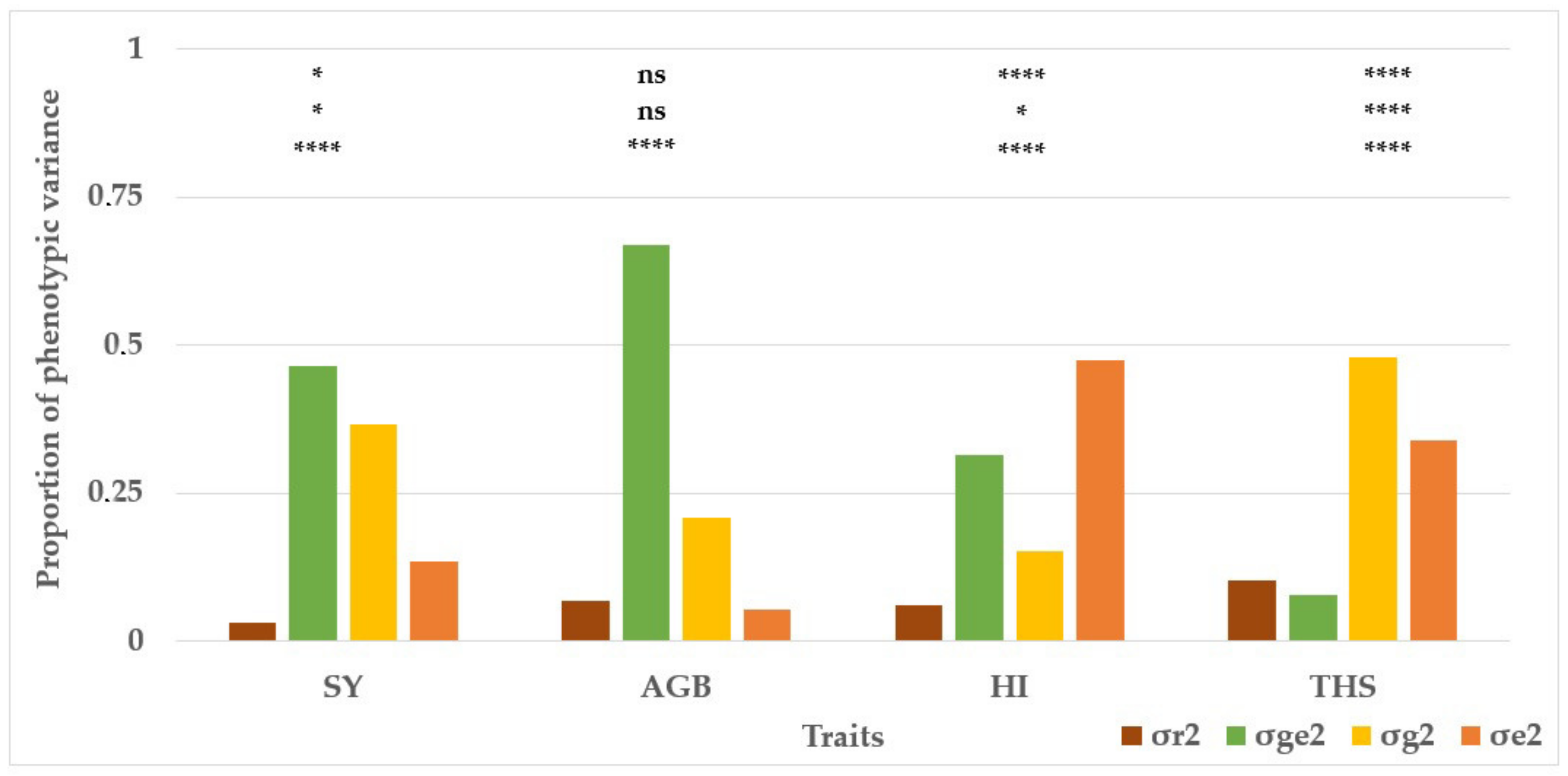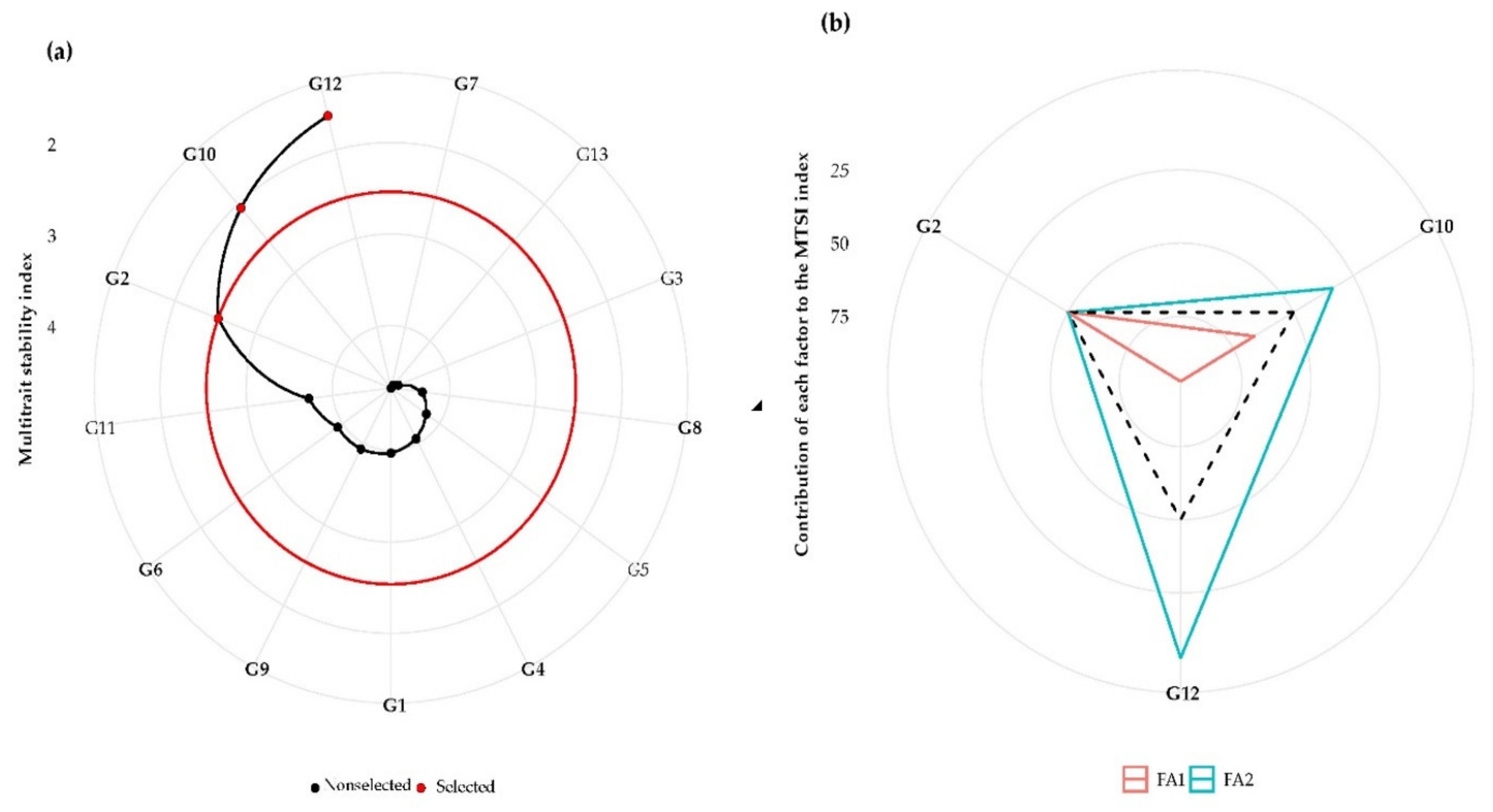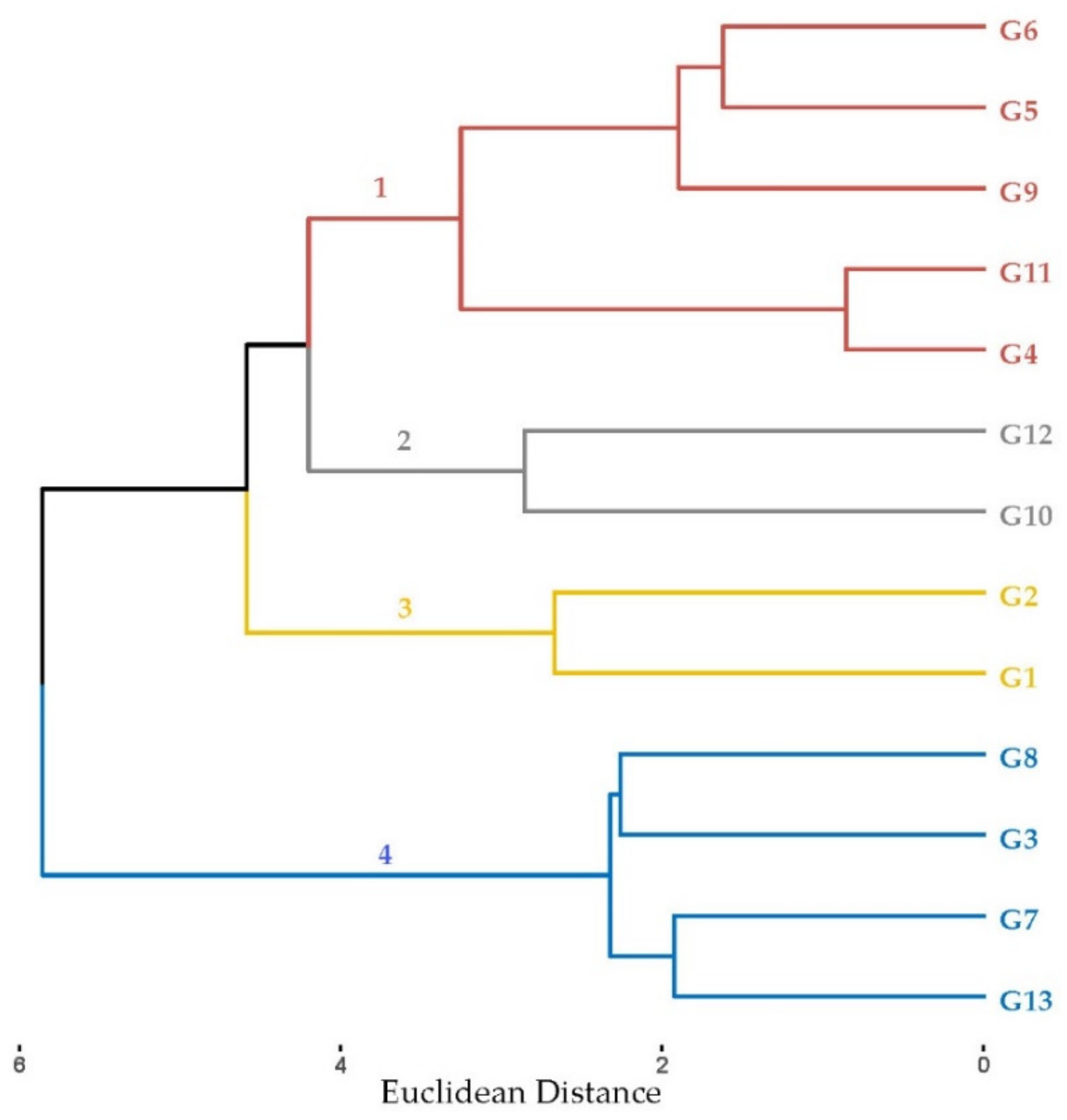Selection of Suitable Genotypes of Lentil (Lens culinaris Medik.) under Rainfed Conditions in South Italy Using Multi-Trait Stability Index (MTSI)
Abstract
:1. Introduction
2. Materials and Methods
2.1. Experimental Site
2.2. Agronomic Management and Experimental Design
2.3. Measurements
2.4. Statistical Analysis
3. Results
3.1. Climatic Conditions
3.2. Likelihood-Ratio Tests and Variance Components
3.3. Principal Component Analysis
3.4. Productivity Performance and Stability
3.5. Multiple Trait Mean Performance and Stability
3.6. Yield Quality
4. Discussion
5. Conclusions
Supplementary Materials
Author Contributions
Funding
Data Availability Statement
Acknowledgments
Conflicts of Interest
References
- Sandhu, J.; Singh, S. History and origin. In Lentil; Yadav, S.S., McNeil, D.L., Stevenson, P.C., Eds.; Springer: Dordrecht, The Netherlands, 2007; pp. 1–9. [Google Scholar] [CrossRef]
- Alexander, W. Lentil Trading and Marketing: Australian Grain Exports. 2015. Available online: https://grdc.com.au/Research-and-Development/GRDC-Update-Papers/2015/08/Lentil-trading-and-marketing (accessed on 27 July 2021).
- Tullu, A.; Diederichsen, A.; Suvorova, G.; Vandenberg, A. Genetic and genomic resources of lentil: Status, use and prospects. Plant Genet. Resour. 2011, 9, 19–29. [Google Scholar] [CrossRef]
- FAOstat. Statistics Database of the Food and Agriculture Organization of the United Nations. 2021. Available online: http://www.fao.org/statistics/databases/en/ (accessed on 27 July 2021).
- ISTAT. Istituto Nazionale di Statistica. Available online: http://dati.istat.it/ (accessed on 27 July 2021).
- Foti, S.; Abbate, V. Lenticchia (Lens cilinaris Medik. o Lens esculenta Moench). In Coltivazioni Erbacee Cereali e Proteagnose; Baldoni, R., Giardini, L., Eds.; Pàtron Editore: Bologna, Italy, 2000; pp. 331–336. [Google Scholar]
- Sellami, M.H.; Pulvento, C.; Lavini, A. Agronomic practices and performances of quinoa under field conditions: A systematic review. Plants 2021, 10, 72. [Google Scholar] [CrossRef]
- Alandia, G.; Pulvento, C.; Sellami, M.H.; Hoidal, N.; Anemone, T.; Nigussie, E.; Agüero, J.J.; Lavini, A.; Jacobsen, S.-E. Grain legumes may enhance high-quality food production in Europe. In Emerging Research in Alternative Crops; Hirich, A., Choukr-Allah, R., Ragab, B., Eds.; Environment & Policy; Springer: Cham, Switzerland, 2020; Volume 58, pp. 25–53. [Google Scholar] [CrossRef]
- Pulvento, C.; Sellami, M.H.; Lavini, A. Yield and quality of Amaranthus hypochondriacus grain amaranth under drought and salinity at various phenological stages in southern Italy. J. Sci. Food Agric. 2021. [Google Scholar] [CrossRef]
- Sellami, M.H.; Pulvento, C.; Aria, M.; Stellacci, A.M.; Lavini, A. A Systematic Review of Field Trials to Synthesize Existing Knowledge and Agronomic Practices on Protein Crops in Europe. Agronomy 2019, 9, 292. [Google Scholar] [CrossRef] [Green Version]
- Singh, D.; Singh, C.K.; Kumari, S.; Tomar, R.S.S.; Karwa, S.; Singh, R.; Pal, M. Discerning morpho-anatomical, physiological and molecular multiformity in cultivated and wild genotypes of lentil with reconciliation to salinity stress. PLoS ONE 2017, 12, e0177465. [Google Scholar] [CrossRef] [PubMed]
- Shrestha, R.; Turner, N.C.; Siddique, K.H.M.; Turner, D.W. Physiological and seed yield responses to water deficits among lentil genotypes from diverse origins. Aust. J. Agric. Res. 2006, 57, 903–915. [Google Scholar] [CrossRef]
- Ruisi, P.; Amato, G.; Badagliacca, G.; Frenda, A.S.; Giambalvo, D.; Di Miceli, G. Agro-ecological benefits of faba bean for rainfed Mediterranean cropping systems. Ital. J. Agron. 2017, 12, 233–245. [Google Scholar] [CrossRef] [Green Version]
- Sarker, A.; Kumar, S. Lentils in production and food systems in West Asia and Africa. International Center for Agricultural Research in the Dry Areas (ICARDA), Aleppo, Syria. Grain Legumes. 2011, 57, 46–48. [Google Scholar]
- Muehlbauer, F.J.; Cubero, J.I.; Summerfield, R.J. Lentil (Lens culinaris Medic.). In Grain Legume Crops; Summerfield, R.J., Roberts, E.H., Eds.; Collins: London, UK, 1985; pp. 266–311. [Google Scholar]
- Tayade, R.; Kulkarni, K.P.; Jo, H.; Song, J.T.; Lee, J.D. Insight Into the Prospects for the Improvement of Seed Starch in Legume—A Review. Front. Plant Sci. 2019, 10, 1213. [Google Scholar] [CrossRef] [PubMed]
- Piergiovanni, A.R. The evolution of lentil (Lens culinaris Medik.) cultivation in Italy and its effects on the survival of autochthonous populations. Genet. Resour. Crop Evol. 2000, 47, 305–314. [Google Scholar] [CrossRef]
- Zaccardelli, M.; Sonnante, G.; Lupo, F.; Branca, F.; de Falco, E. (Eds.) Leguminose minori (cece, lenticchia, cicerchia, fava); Consiglio per Ricerca Sperimentazione Agricoltura: Rome, Italy, 2010; p. 73. ISBN 978-88-97081-00-5. [Google Scholar]
- Rana, M.; Sood, A.; Hussain, W.; Kaldate, R.; Sharma, T.R.; Gill, R.K.; Kumar, S.; Singh, S. Chapter 6—Gene Pyramiding and Multiple Character Breeding. In Lentils: Potential Resources for Enhancing Genetic Gains; Singh, M., Ed.; Academic Press: Cambridge, MA, USA, 2019; pp. 83–124. Available online: https://www.sciencedirect.com/science/article/pii/B9780128135228000066 (accessed on 27 July 2021).
- Olivoto, T.; Nardino, M. MGIDI: Toward an effective multivariate selection in biological experiments. Bioinformatics 2021, 37, 1383–1389. [Google Scholar] [CrossRef]
- Smith, H.F. A discriminant function for plant selection. Ann.Eugen. 1936, 7, 240–250. [Google Scholar] [CrossRef]
- Rocha, J.R.A.S.C.; Machado, J.C.; Carneiro, P.C.S. Multitrait index based on factor analysis and ideotype-design: Proposal and application on elephant grass breeding for bioenergy. GCB Bioenergy 2018, 10, 52–60. [Google Scholar] [CrossRef]
- Olivoto, T.; Lúcio, A.D.; da Silva, J.A.; Sari, B.G.; Diel, M.I. Mean performance and stability in multi-environment trials II: Selection based on multiple traits. J. Agron. 2019, 111, 2961–2969. [Google Scholar] [CrossRef]
- Authrapun, J.; Lertsuchatavanich, U.; Kang, D. Selection for Improving Field Resistance to Capsicum Chlorosis Virus and Yield-related Traits Using Selection Indices in Peanut Breeding. Acta Sci. Agric. 2021, 5, 22–31. [Google Scholar] [CrossRef]
- Allen, R.G.; Pereira, L.S.; Raes, D.; Smith, M. (Eds.) Crop evapotranspiration guidelines for computing crop water requirements. In Irrigation and Drainage Paper 56; FAO: Rome, Italy, 1998. [Google Scholar]
- USDA. Keys to Soil Taxonomy, 10th ed.; Soil Survey Staff; US Department of Agriculture NRCS: Washington, DC, USA, 2006.
- Mariotti, F.; Tomé, D.; Mirand, P.P. Converting Nitrogen into Protein—Beyond 6.25 and Jones’ Factors. Crit. Rev. Food Sci. Nutr. 2008, 48, 177–184. [Google Scholar] [CrossRef]
- AOAC. Official method 922.06. Fat in flour. Acid hydrolysis method. In Official Methods of Analysis of AOAC International, 19th ed.; AOAC International: Gaithersburg, MD, USA, 2012. [Google Scholar]
- Box, G.E.P.; Cox, D.R. An analysis of transformations. J. R. Stat. Soc. Series B 1964, 26, 211–252. [Google Scholar] [CrossRef]
- Henderson, C.R. Best linear unbiased estimation and prediction under a selection model. Biometrics 1975, 423–447. [Google Scholar] [CrossRef] [PubMed] [Green Version]
- Olivoto, T.; Lúcio, A.D.; da Silva, J.A.; Marchioro, V.S.; de Souza, V.Q.; Jost, E. Mean performance and stability in multi-environment trials I: Combining features of AMMI and BLUP techniques. Agron. J. 2019, 111, 2949–2960. [Google Scholar] [CrossRef]
- Olivoto, T.; Lúcio, A.D.C. metan: An R package for multi-environment trial analysis. Methods Ecol. Evol. 2020, 11, 783–789. [Google Scholar] [CrossRef]
- R Core Team. R: A Language and Environment for Statistical Computing; R Foundation for Statistical Computing: Vienna, Austria, 2013; Available online: https://www.scirp.org/(S(vtj3fa45qm1ean45vvffcz55))/reference/ReferencesPapers.aspx?ReferenceID=1742158 (accessed on 1 March 2021).
- Husson, F.; Josse, J.; Le, S.; Mazet, J. Facto Mine R: Multivariate Exploratory Data Analysis and Data Mining with R. R Package Version.1. 2014, pp. 102–123. Available online: http://factominer.free.fr/ (accessed on 1 March 2021).
- Friendly, M. Corrgrams: Exploratory displays for correlation matrices. Am. Stat. 2002, 56, 316–324. [Google Scholar] [CrossRef]
- Datta, S.; Datta, S. Methods for evaluating clustering algorithms for gene expression data using a reference set of functional classes. BMC Bioinform. 2006, 7, 397. [Google Scholar] [CrossRef] [PubMed]
- Gibbs, W.J.; Maher, J.V. Rainfall deciles as drought indicators. Bureau of Meteorology. Melbourne 1967, 48, 37. [Google Scholar]
- FAO. 2016 International Year of Pulses. Available online: http://www.fao.org/pulses-2016/about/en/ (accessed on 27 July 2021).
- Ezatollah, F.; Hassan, Z.; Reza, M. Evaluation of phenotypic stability in chickpea genotypes using GGE-Biplot. Ann. Biol. Res. 2011, 2, 282–292. [Google Scholar]
- INRA. Guide Pratique Pour le Conseil Agricole: Lentille, Pois Chiche et Fève/دليل الاستشارة الفلاحية العدس الحمص والفول (Ar, Fr) Rabat (Ma). 2015; 56p. Available online: https://www.inra.org.ma/fr/content/guide-pratique-pour-le-conseil-agricole-lentille-pois-chiche-et-f%C3%A8ve (accessed on 2 September 2021).
- Nezami, A.; Bandara, M.S.; Gusta, L.V. An evaluation of freezing tolerance of winter chickpea (Cicer arietinum L.) using controlled freeze tests. Can. J. Plant. Sci. 2012, 92, 155–161. [Google Scholar] [CrossRef]
- Croser, J.S.; Clarke, H.J.; Siddique, K.H.M.; Khan, T.N. Low-temperature stress: Implications for chickpea (Cicer arietinum L.) improvement. CRC. Crit. Rev. Plant. Sci. 2003, 22, 185–219. [Google Scholar] [CrossRef]
- Sellami, M.H.; Pulvento, C.; Amarowicz, R.; Lavini, A. Field phenotyping and quality traits of grass pea genotypes in South Italy. J. Sci. Food Agric. 2020. [Google Scholar] [CrossRef]
- Sellami, M.H.; Lavini, A.; Pulvento, C. Phenotypic and quality traits of chickpea genotypes under rainfed conditions in south Italy. Agronomy 2021, 11, 962. [Google Scholar] [CrossRef]
- Sabaghnia, N.; Dehghani, H.; Sabaghpour, S.H. Graphic analysis of genotype by environment interaction for lentil yield in Iran. Agron. J. 2008, 100, 760–764. [Google Scholar] [CrossRef]
- Dehghani, H.; Sabaghpour, S.H.; Sabaghnia, N. Genotype x environment interaction for grain yield of some lentil genotypes and relationship among univariate stability statistics. Span. J. Agric. Res. 2008, 6, 385–394. [Google Scholar] [CrossRef] [Green Version]
- Benakanahalli, N.K.; Sridhara, S.; Ramesh, N.; Olivoto, T.; Sreekantappa, G.; Tamam, N.; Abdelbacki, A.M.M.; Elansary, H.O.; Abdelmohsen, S.A.M. A Framework for Identification of Stable Genotypes Basedon MTSI and MGDII Indexes: An Example in Guar (Cymopsis tetragonoloba L.). Agronomy 2021, 11, 1221. [Google Scholar] [CrossRef]
- Olivoto, T.; Nardino, M.; Meira, D.; Meier, C.; Follmann, D.N.; Souza, V.Q.; Konflanz, V.A.; Baretta, D. Multi-trait selection for mean performance and stability in maize. Agron. J. 2021, 1–16. [Google Scholar] [CrossRef]
- Picard, J. Some results dealing with breeding for protein content in Vicia faba L. In Protein Quality from Leguminous Crops; EUR 5686 Agricultural Research Series; INRS Station d’Amélioration des Plantes: Dijon, France, 1977; pp. 339–347. [Google Scholar]
- El-Sherbeeny, M.H.; Robertson, L.D. Protein content variation in a pure line faba bean (Vicia faba) collection. J. Sci. Food Agric. 1992, 58, 193–196. [Google Scholar] [CrossRef]






| Code | Accession Name | Purveyor | Country |
|---|---|---|---|
| G1 | Itaca | ISEA | Italy |
| G2 | Altamura | Western Regional Pl Station | United States |
| G3 | Gaia | ISEA | Italy |
| G4 | ESTON LSF | Western Regional Pl Station | United States |
| G5 | TIPO CASTELLUCCIO PlCCOLE | “ | “ |
| G6 | Mountain Lentil #1 | “ | “ |
| G7 | ILL 508 | “ | “ |
| G8 | Castelluccio Lentil | “ | “ |
| G9 | Mountain Lentil #2 | “ | “ |
| G10 | ESTON | “ | “ |
| G11 | W6 19546 | “ | “ |
| G12 | Caltagirone | ISAFoM-Sicilia | Italy |
| G13 | di Colliano | IBBR-CNR | “ |
| Source of Variation | Growing Season | Mean | ||
|---|---|---|---|---|
| 2017 | 2018 | 2019 | ||
| SY (g m−2) | 111 ± 59 b | 129 ± 64 a | 71 ± 72 c | 104 ± 69 |
| AGB (g m−2) | 627 ± 265 b | 603 ± 224 b | 799 ± 410 a | 676 ± 320 |
| HI (%) | 18.09 ± 8.14 b | 21.73 ± 8.36 a | 7.53 ± 5.36 c | 15.78 ± 9.52 |
| THS (g) | 37.76 ± 12.61 a | 34.56 ± 10.32 b | 22.57 ± 9.14 c | 31.63 ± 12.55 |
| Factor Components | FA1 | FA2 | Communality | Uniquenesses |
|---|---|---|---|---|
| Eigenvalue | 1.96 | 1.06 | – | – |
| Relative variance (%) | 49.10 | 26.41 | – | – |
| Cumulative variance (%) | 49.10 | 75.51 | – | – |
| Eigenvectors | ||||
| SY | −0.80 | 0.47 | 0.87 | 0.13 |
| AGB | −0.87 | 0.11 | 0.77 | 0.23 |
| THS | −0.66 | −0.28 | 0.52 | 0.48 |
| HI | −0.02 | 0.93 | 0.87 | 0.13 |
| Variables | Factor | Xo | Xs | SD | SDperc |
|---|---|---|---|---|---|
| SY | FA 1 | 54.2 | 80.8 | 26.6 | 49.0 |
| AGB | FA 1 | 45.4 | 69.7 | 24.3 | 53.6 |
| HS | FA 1 | 54.4 | 64.6 | 10.2 | 18.8 |
| HI | FA 2 | 57.6 | 73.1 | 15.5 | 26.9 |
| Starch (g/100g Dry Weight) | Ashes (%) | Protein Concentration (%) | Fat (%) | Protein Yield (g m−2) | |
|---|---|---|---|---|---|
| Group 1 | 47.08 ± 1.73 | 5.19 ± 1.85 | 23.84 ± 1.3 | 2.19 ± 0.07 | 15.96 ± 7.64 |
| Group 2 | 46.45 ± 0.35 | 5.01 ± 2.64 | 22.9 ± 2.12 | 2.47 ± 0.23 | 41.59 ± 4.21 |
| Group 3 | 41.05 ± 0.35 | 7.57 ± 3.19 | 22.2 ± 1.41 | 1.47 ± 0.2 | 23.833 ± 1.99 |
| Group 4 | 36.8 ± 3.33 | 4.29 ± 1.25 | 24.93 ± 0.77 | 2.57 ± 0.42 | 16.60 ± 7.11 |
Publisher’s Note: MDPI stays neutral with regard to jurisdictional claims in published maps and institutional affiliations. |
© 2021 by the authors. Licensee MDPI, Basel, Switzerland. This article is an open access article distributed under the terms and conditions of the Creative Commons Attribution (CC BY) license (https://creativecommons.org/licenses/by/4.0/).
Share and Cite
Sellami, M.H.; Pulvento, C.; Lavini, A. Selection of Suitable Genotypes of Lentil (Lens culinaris Medik.) under Rainfed Conditions in South Italy Using Multi-Trait Stability Index (MTSI). Agronomy 2021, 11, 1807. https://doi.org/10.3390/agronomy11091807
Sellami MH, Pulvento C, Lavini A. Selection of Suitable Genotypes of Lentil (Lens culinaris Medik.) under Rainfed Conditions in South Italy Using Multi-Trait Stability Index (MTSI). Agronomy. 2021; 11(9):1807. https://doi.org/10.3390/agronomy11091807
Chicago/Turabian StyleSellami, Mohamed Houssemeddine, Cataldo Pulvento, and Antonella Lavini. 2021. "Selection of Suitable Genotypes of Lentil (Lens culinaris Medik.) under Rainfed Conditions in South Italy Using Multi-Trait Stability Index (MTSI)" Agronomy 11, no. 9: 1807. https://doi.org/10.3390/agronomy11091807
APA StyleSellami, M. H., Pulvento, C., & Lavini, A. (2021). Selection of Suitable Genotypes of Lentil (Lens culinaris Medik.) under Rainfed Conditions in South Italy Using Multi-Trait Stability Index (MTSI). Agronomy, 11(9), 1807. https://doi.org/10.3390/agronomy11091807







